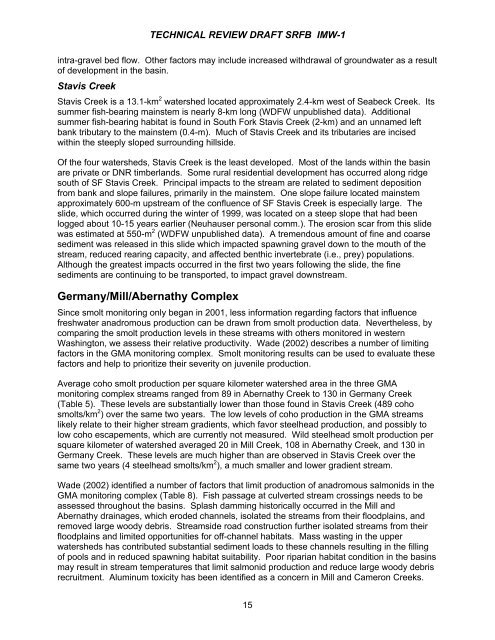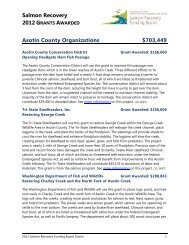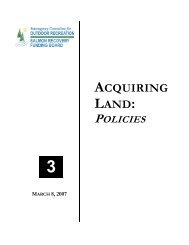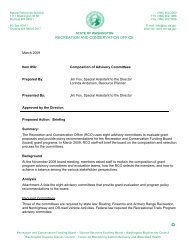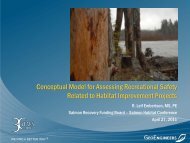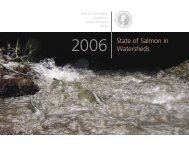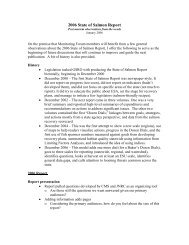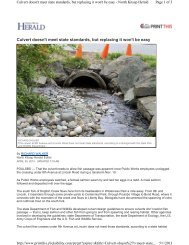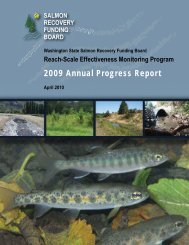Proposal to Establish Intensively Monitored Watersheds for ...
Proposal to Establish Intensively Monitored Watersheds for ...
Proposal to Establish Intensively Monitored Watersheds for ...
- No tags were found...
You also want an ePaper? Increase the reach of your titles
YUMPU automatically turns print PDFs into web optimized ePapers that Google loves.
TECHNICAL REVIEW DRAFT SRFB IMW-1intra-gravel bed flow. Other fac<strong>to</strong>rs may include increased withdrawal of groundwater as a resul<strong>to</strong>f development in the basin.Stavis CreekStavis Creek is a 13.1-km 2 watershed located approximately 2.4-km west of Seabeck Creek. Itssummer fish-bearing mainstem is nearly 8-km long (WDFW unpublished data). Additionalsummer fish-bearing habitat is found in South Fork Stavis Creek (2-km) and an unnamed leftbank tributary <strong>to</strong> the mainstem (0.4-m). Much of Stavis Creek and its tributaries are incisedwithin the steeply sloped surrounding hillside.Of the four watersheds, Stavis Creek is the least developed. Most of the lands within the basinare private or DNR timberlands. Some rural residential development has occurred along ridgesouth of SF Stavis Creek. Principal impacts <strong>to</strong> the stream are related <strong>to</strong> sediment depositionfrom bank and slope failures, primarily in the mainstem. One slope failure located mainstemapproximately 600-m upstream of the confluence of SF Stavis Creek is especially large. Theslide, which occurred during the winter of 1999, was located on a steep slope that had beenlogged about 10-15 years earlier (Neuhauser personal comm.). The erosion scar from this slidewas estimated at 550-m 2 (WDFW unpublished data). A tremendous amount of fine and coarsesediment was released in this slide which impacted spawning gravel down <strong>to</strong> the mouth of thestream, reduced rearing capacity, and affected benthic invertebrate (i.e., prey) populations.Although the greatest impacts occurred in the first two years following the slide, the finesediments are continuing <strong>to</strong> be transported, <strong>to</strong> impact gravel downstream.Germany/Mill/Abernathy ComplexSince smolt moni<strong>to</strong>ring only began in 2001, less in<strong>for</strong>mation regarding fac<strong>to</strong>rs that influencefreshwater anadromous production can be drawn from smolt production data. Nevertheless, bycomparing the smolt production levels in these streams with others moni<strong>to</strong>red in westernWashing<strong>to</strong>n, we assess their relative productivity. Wade (2002) describes a number of limitingfac<strong>to</strong>rs in the GMA moni<strong>to</strong>ring complex. Smolt moni<strong>to</strong>ring results can be used <strong>to</strong> evaluate thesefac<strong>to</strong>rs and help <strong>to</strong> prioritize their severity on juvenile production.Average coho smolt production per square kilometer watershed area in the three GMAmoni<strong>to</strong>ring complex streams ranged from 89 in Abernathy Creek <strong>to</strong> 130 in Germany Creek(Table 5). These levels are substantially lower than those found in Stavis Creek (489 cohosmolts/km 2 ) over the same two years. The low levels of coho production in the GMA streamslikely relate <strong>to</strong> their higher stream gradients, which favor steelhead production, and possibly <strong>to</strong>low coho escapements, which are currently not measured. Wild steelhead smolt production persquare kilometer of watershed averaged 20 in Mill Creek, 108 in Abernathy Creek, and 130 inGermany Creek. These levels are much higher than are observed in Stavis Creek over thesame two years (4 steelhead smolts/km 2 ), a much smaller and lower gradient stream.Wade (2002) identified a number of fac<strong>to</strong>rs that limit production of anadromous salmonids in theGMA moni<strong>to</strong>ring complex (Table 8). Fish passage at culverted stream crossings needs <strong>to</strong> beassessed throughout the basins. Splash damming his<strong>to</strong>rically occurred in the Mill andAbernathy drainages, which eroded channels, isolated the streams from their floodplains, andremoved large woody debris. Streamside road construction further isolated streams from theirfloodplains and limited opportunities <strong>for</strong> off-channel habitats. Mass wasting in the upperwatersheds has contributed substantial sediment loads <strong>to</strong> these channels resulting in the fillingof pools and in reduced spawning habitat suitability. Poor riparian habitat condition in the basinsmay result in stream temperatures that limit salmonid production and reduce large woody debrisrecruitment. Aluminum <strong>to</strong>xicity has been identified as a concern in Mill and Cameron Creeks.15


